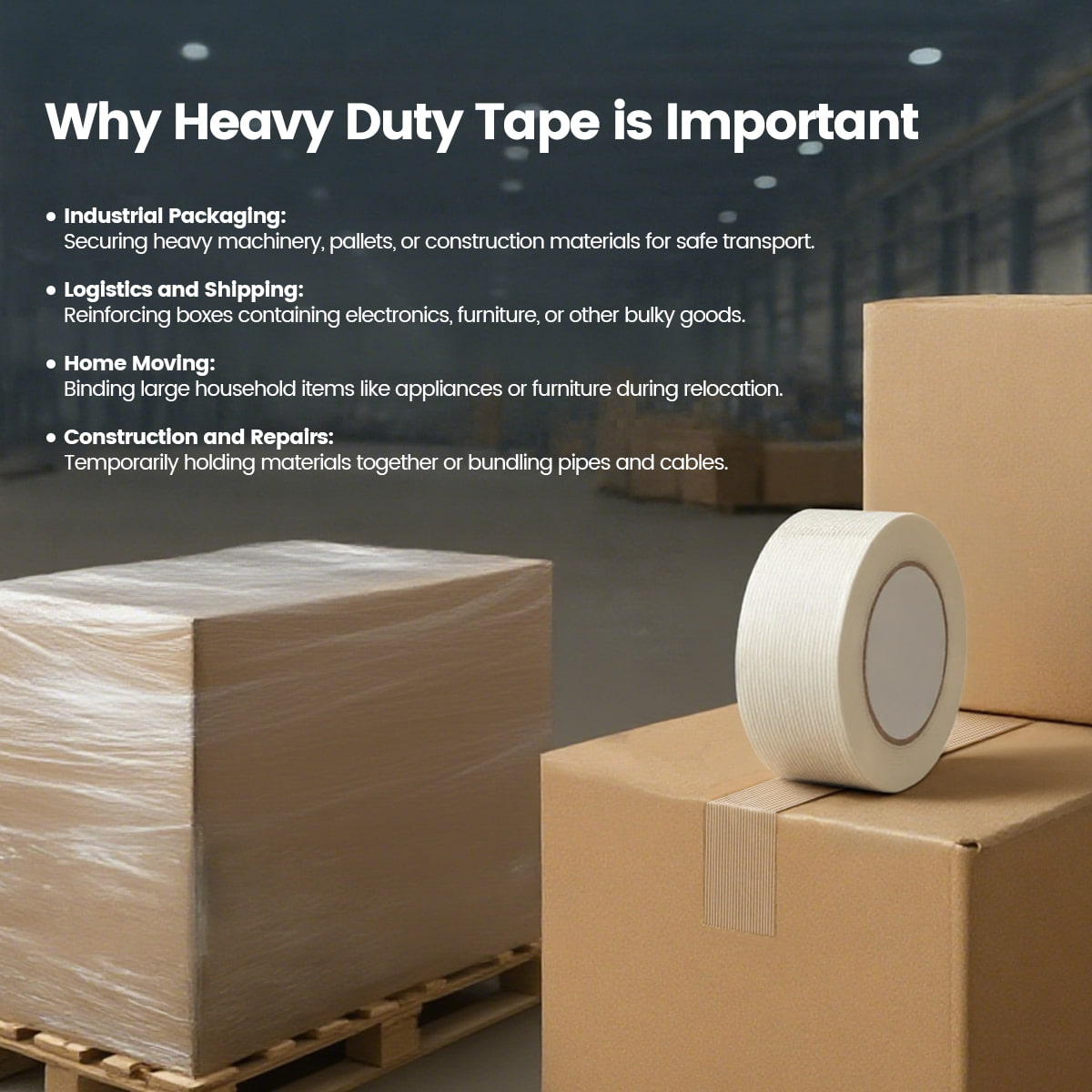JL3 Heavy-Duty Tape: The Science from “Sticking” to “Staying Put

In warehouses, trucks, jobsites, or during a move, you’ll often see a roll of tape with a fibrous texture. It looks ordinary, yet it often determines whether a shipment, an appliance, or a temporary setup can survive transport and time.
This article explains the principles, materials, selection, and use of heavy-duty tape, so you can apply it correctly across four typical scenarios—industrial packaging, logistics and shipping, home moves, and construction/repair.
What Makes Heavy-Duty Tape “Heavy-Duty”?
Heavy-duty tape isn’t just “stickier” tape. It typically offers three core capabilities:
1.High tensile strength: The backing incorporates glass or polyester fibers (unidirectional or cross-weave), essentially adding “rebar” so it won’t snap under load.
2.High shear holding power: It resists slow creep under sustained load or elevated temperature.
3.Abrasion resistance and anti-splitting: It resists tear propagation when edges are pulled or abraded.
Typical structure: backing (BOPP, PET, cloth, etc.) + reinforcement fibers + pressure-sensitive adhesive (PSA) + release coating. Different combinations define its behavior and applications.
Why Does It Stick? (Three Fundamentals of Adhesion)
Contact area: A PSA needs pressure to wet out, flowing into micro-pores of substrates like corrugated board. The more complete the contact, the stronger the adhesion.
Surface energy: On low-surface-energy materials (e.g., PE, PP, waxed or oily surfaces—think nonstick pans), the adhesive struggles to wet out. Cleaning, degreasing, abrasion, or choosing a specialty adhesive is essential.
Tack–elasticity balance: The adhesive must be “syrupy” enough to grab the surface (initial tack) yet “rubbery” enough to bear load (cohesive strength). High-tack formulas aren’t always durable; ultra-durable ones may have moderate initial tack—select according to what the scenario values most.
Choosing Adhesives and Backings
Rubber-based: High initial tack, fast grab, good value; lower heat and aging resistance. Suited for general in-warehouse sealing and short-term bundling.
Hot-melt (rubber/resin-modified): Efficient to process with rapid bond-up; widely used on packaging lines.
Acrylic: Superior temperature, UV, and aging resistance—ideal for outdoor, large temperature swings, or long-term use.
Reinforcement & backing
Unidirectional fiberglass: Extremely strong along the fiber direction—good for strapping and binding.
Cross-weave fiberglass: Stable under multidirectional loads—good for heavy-carton reinforcement and H-pattern sealing.
Cloth/PET backing: Excellent tear and abrasion resistance—more abuse-tolerant for jobsite temporary fixes.
Four Scenarios: Selection & Practice
1. Industrial Packaging (equipment, pallets, materials)
Selection: Cross-weave fiberglass reinforcement, high shear holding power, abrasion-resistant backing.
Method: Corner protectors → stretch wrap for unitization → heavy-duty tape reinforcing along load paths (“cross + wrap”). Use an H-pattern carton seal (one strip along the center seam, one on each edge), and add vertical-edge strips to create an “invisible frame.”
Pairing with strapping: Straps take the primary tensile load; tape “stitches” the system together to prevent shifting and in-plane tearing.
2. Logistics & Shipping (long haul, frequent handling)
Risks: Wide swings in temperature/humidity, vibration, and high stacking pressure.
Selection: Temperature- and moisture-resistant acrylic adhesive; cross-weave reinforcement; wider tape for heavy loads to distribute stress.
Details: Reinforcing all four vertical edges markedly reduces box blowouts; combine corner protectors and void fill to avoid stress concentrations.
3. Home Moves (appliances, furniture, rugs)
Method: First isolate surfaces with stretch wrap, then use heavy-duty tape in “seal-strip” fashion to secure doors, drawers, and power cords; finish with small pull tabs for easy removal.
Notes: Do not apply tape directly to paint, veneer, leather, or screens; degrease and dry glass and metal before taping.
4. Construction & Repair (temporary fixing, cable routing, curing support)
Role: Temporary support so permanent fasteners (bolts, clamps) or structural adhesives can take over once set.
Selection: high-strength filament tape—abrasion-resistant, hand-tearable, high initial tack.
No-go zones: Pressurized piping, long-term outdoor load-bearing, and fire-rated applications—tape must not be the final structural solution.
Three Steps to Correct Application
Surface prep: Remove dust and oil; keep dry. At low temperatures the adhesive stiffens—apply at room temperature whenever possible.
Pressure & dwell: After applying, press firmly along the tape and especially the edges (squeegee or palm) to promote wet-out; allow dwell time to strengthen the bond.
Load path: Strap along the principal load direction; use H-pattern plus edge reinforcement for cartons; add secondary patches over sharp corners or cut edges to prevent tear propagation.